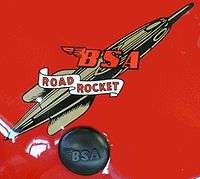BSA Road Rocket
|
| |
| Manufacturer | BSA |
|---|---|
| Production | 1954-1958 |
| Assembly | Small Heath, Birmingham, UK |
| Successor | BSA Super Rocket |
| Engine | 646 cc air cooled twin |
| Bore / stroke | 70 mm × 84 mm (2.8 in × 3.3 in)[1] |
| Power | 40 bhp (30 kW) @ 6,000rpm[2] |
| Ignition type | Magneto |
| Transmission | Four speed, chain drive |
| Suspension | Telescopic fork (front), swinging arm (rear) |
| Brakes | Drum |
| Wheelbase | 54.75 in (1,391 mm) |
| Dimensions |
L: 84 in (2,100 mm) |
| Weight |
418 pounds (190 kg)[3] (dry) |
| Fuel capacity | 3.5 imp gal (16 L) |
| Fuel consumption | 50 mpg‑imp (5.6 L/100 km)[3] |
The BSA Road Rocket was a 1950s 646 cc (39.4 cu in) air-cooled parallel twin motorcycle designed by Bert Hopwood and produced by Birmingham Small Arms Company (BSA) at Small Heath, Birmingham. Developed from the A10 Golden Flash it was the first sports bike in the BSA A10 series. The A10 had a reputation for reliability but was struggling to compete against the Triumph engines and the Norton Featherbed frames.[4] Advertised by BSA in 1954 as 'undoubtedly the worlds greatest motorcycle'[5] the Road Rocket was discontinued in 1958 when it was replaced by the BSA Super Rocket.[6]
Development

Launched as the top of BSA's range in 1954 the BSA Road Rocket was the first A10 engine with an alloy cylinder head.[2] Unlike the Golden Flash, the inlet manifold was separate to the cylinder head[7] enabling twin carburettors to be fitted if required.[6] It had a single Amal TT carburettor standard.[8]
New "thick flange" cylinders were introduced and thee bottom flange was increased from 3⁄8 to 1⁄2 in (9.5 to 12.7 mm) for improved rigidity and reliability.[7] The big end size was increased from 1.48" to 1.68".[9] It had high compression pistons and a higher lift camshaft with the 356 "sports" profile.[10] These engine modifications raised the power output to 40 bhp (30 kW)[2] and a top speed of 109 mph (175 km/h).[11]
The model was launched with chrome mudguards and stays and a half-chrome petrol tank. A tachometer was an optional extra.[11]
In 1957 an improved clutch was introduced, using 4 springs instead of six[12] and improved friction material.[13]
See also
References
- ↑ "BSA A10". Classic-British-Motorcycles.com. Retrieved 8 July 2018.
- 1 2 3 Hoseason, Rowena. "BSA A10 Classic Motorcycle Buying Guide". Real Classic. Retrieved 7 July 2018.
- 1 2 "BSA Road Rocket". MCS. Retrieved 10 July 2018.
- ↑ "BSA Golden Flash on test". Classic Bike Guide. May 2008.
- ↑ "BSA Sales Brochure". Retrieved 2009-01-17.
- 1 2 "BSA Twins". Retrieved 2009-01-17.
- 1 2 "Pre-Unit A Group". www.draganfly.co.uk. Retrieved 7 July 2018.
- ↑ "Carburettor Settings – B.S.A" (PDF). Draganfly Motorcycles. Retrieved 7 July 2018.
- ↑ "Pre-Unit A Group". draganfly.co.uk. Retrieved 8 July 2018.
- ↑ "Pre-Unit A Group". www.draganfly.co.uk. Retrieved 7 July 2018.
- 1 2 "1954 BSA A10 Road Rocket". Bike-urious. 18 December 2017. Retrieved 7 July 2018.
- ↑ "BSA A10 Golden Flash Buyers guide". Sump. Retrieved 8 July 2018.
- ↑ Assoc, American Motorcyclist (1957). American Motorcyclist. American Motorcyclist Assoc.
Further reading
- Bacon, Roy (1989). BSA A7/A10 Twins, All Models, 1946-1963. Niton Publishing. ISBN 9780951420454. ASIN 0951420453.
- Henshaw, Peter (2008). BSA 500 & 650 Twins: The Essential Buyer's Guide. Veloce Publishing. ISBN 9781845841362.
- Wright, Professor Owen (1984). BSA A7 & A10 Twins Super Profile (First ed.). G T Foulis & Co Ltd. ISBN 9780854294466. ASIN 0854294465.
- BSA Twins A7 & A10 1946-1962: Road Test Book (First ed.). Brooklands Books. 1996. ISBN 9781855203365. ASIN 1855203367.